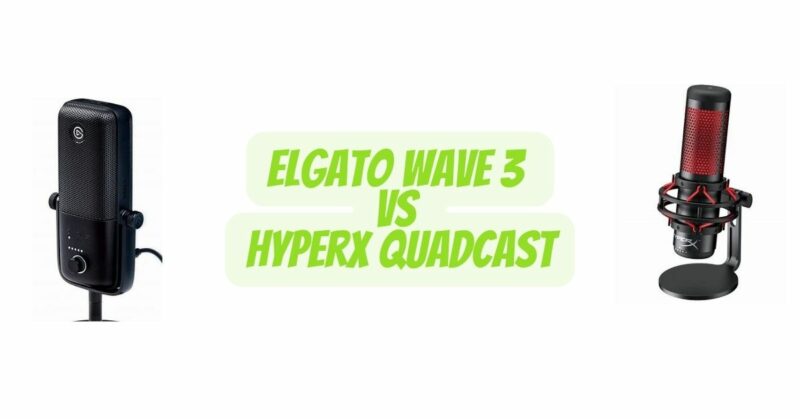USB microphones have revolutionized the world of content creation by providing convenient and high-quality audio solutions. Two popular options in this space are the Elgato Wave 3 and the HyperX Quadcast. These microphones are renowned for their exceptional performance and features, making it challenging for creators to decide between them. In this article, we will compare and contrast the Elgato Wave 3 and the HyperX Quadcast to help you make an informed choice for your recording needs.
Design and Build Quality:
Both the Elgato Wave 3 and the HyperX Quadcast boast impressive designs and build quality. The Wave 3 features a sleek and compact form factor with a sturdy metal construction that exudes a premium feel. It offers a minimalist aesthetic that appeals to modern content creators. On the other hand, the Quadcast sports a more robust build with a durable metal grille and a unique stand design. It has a larger footprint, which may be preferred by users looking for a more substantial presence on their desk.
Audio Quality and Performance:
The audio quality of a microphone is paramount in content creation. The Elgato Wave 3 incorporates a condenser capsule with a 24-bit analog-to-digital converter, delivering clear and detailed sound reproduction. It features Elgato’s proprietary Clipguard technology, which prevents distortion even at high volumes, making it an ideal choice for streamers and podcasters who require pristine audio.
In comparison, the HyperX Quadcast utilizes a condenser microphone with a 14mm diaphragm, delivering rich and warm audio. It offers four selectable polar patterns: cardioid, bidirectional, omnidirectional, and stereo, allowing for versatile recording options. This versatility makes the Quadcast suitable for various applications, including interviews, roundtable discussions, and solo recordings. While both microphones provide exceptional audio quality, the Quadcast’s multiple polar patterns give it an edge in flexibility.
Features and Customization:
Both the Elgato Wave 3 and the HyperX Quadcast come equipped with features that enhance the recording experience. The Wave 3 features a capacitive sensor on the top of the microphone, enabling quick and intuitive mute control with a simple tap. It also includes an integrated digital mixer, allowing you to adjust audio levels for your microphone and other sources directly from your computer. This feature is particularly useful for content creators who require real-time audio monitoring.
On the other hand, the HyperX Quadcast offers a convenient and easily accessible gain control knob located at the bottom of the microphone. It allows for on-the-fly adjustments to the microphone sensitivity, ensuring optimal audio capture in different recording environments. The Quadcast also includes a built-in pop filter to reduce plosive sounds, minimizing the need for additional accessories. Additionally, the Quadcast features customizable RGB lighting, enabling users to personalize the appearance of the microphone to suit their aesthetic preferences.
Compatibility and Connectivity:
Both the Elgato Wave 3 and the HyperX Quadcast are USB microphones, ensuring seamless compatibility with a wide range of devices. They are compatible with Windows, macOS, and PlayStation 4, making them versatile options for various setups. The Wave 3 utilizes a USB-C connection, while the Quadcast uses a traditional USB-A connection. It’s worth noting that the Wave 3 also offers a headphone output with zero-latency monitoring, allowing for real-time monitoring of the audio without any delays.
Price and Value:
Price is an important consideration when choosing a USB microphone. The Elgato Wave 3 generally falls within a higher price range compared to the HyperX Quadcast. While the Wave 3 offers advanced features, a compact design, and Elgato’s proprietary technologies, the Quadcast provides flexibility with its multiple polar patterns and customizable lighting at a more affordable price point.
Conclusion:
In the Elgato Wave 3 vs. HyperX Quadcast comparison, both microphones offer exceptional audio quality, build quality, and features. The Elgato Wave 3 stands out with its compact design, Clipguard technology, and integrated digital mixer, making it an excellent choice for creators seeking simplicity and clarity. On the other hand, the HyperX Quadcast shines with its multiple polar patterns, gain control knob, and customizable RGB lighting, providing versatility and personalization options.
Ultimately, the choice between these microphones depends on your specific needs and preferences. If you value a sleek design, advanced digital processing, and real-time monitoring, the Elgato Wave 3 is an excellent option. However, if you require multiple polar patterns, customizable controls, and an affordable price, the HyperX Quadcast might be the better choice for you. Regardless of your decision, both microphones deliver outstanding performance and are worthy contenders in the USB microphone market.

